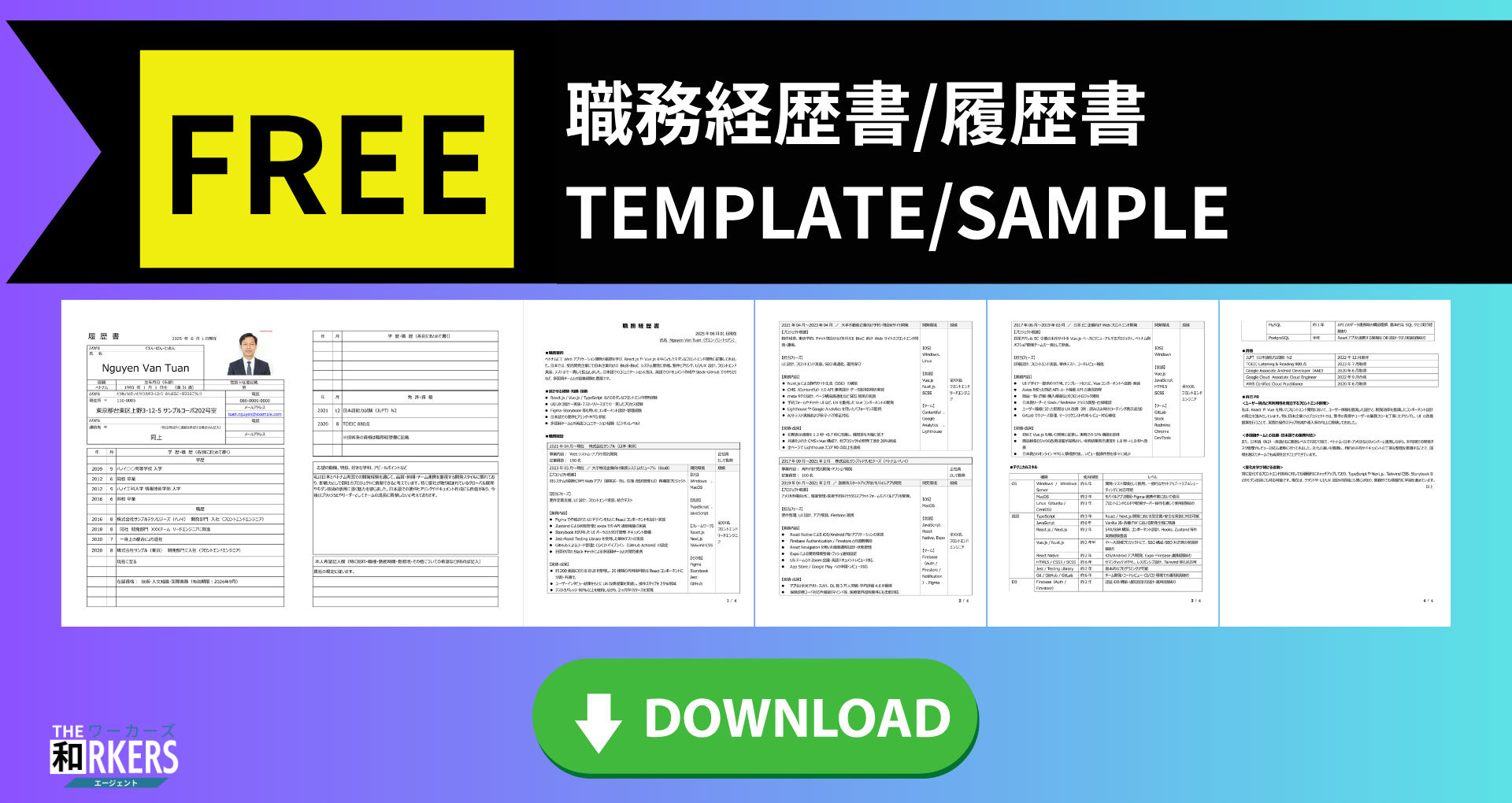How to Write a Japanese Resume and CV for IT Jobs in Japan (with Templates)

For many foreign professionals aiming to work in Japan as IT engineers, data scientists, or IT consultants, one of the first major hurdles is preparing the necessary documents.
In particular, Japanese business culture places great importance on the format and content of resumes (rirekisho) and CVs (shokumukeirekisho), with many unspoken rules and expectations. It’s not uncommon for applicants to feel unsure about how to write them properly.
To help with this, THE 和RKERS—a recruitment agency that specializes in supporting foreign IT professionals—has created Japanese-style resume and CV templates based on real-world experience and proven success.
These templates are available for free download, so feel free to take advantage of them.
We also provide assistance with Japanese writing and expressions to ensure your documents meet local standards.
In addition, we can introduce you to companies in Japan that actively hire foreign IT talent.
If you’re serious about building your career in Japan, don’t hesitate to reach out to us for support.
Two Documents You Need for Job Hunting in Japan
What Is a Rirekisho (Japanese Resume)?
A rirekisho is a standardized resume used in Japan to present your basic personal and professional information in a clear, factual manner.
It typically includes your full name, address, date of birth, contact details, educational background, work history, qualifications, and motivation for applying.
The format is fairly fixed and is considered an essential part of the job application process, especially for traditional Japanese companies.
For new graduates and foreign applicants in particular, the correctness and neatness of the rirekisho itself can be part of the evaluation. That’s why it’s important to fill it out carefully—either by hand or using a proper PDF form.
Beyond the content, the rirekisho also serves as a way to demonstrate that you understand Japanese business etiquette and that you are a serious and professional candidate.
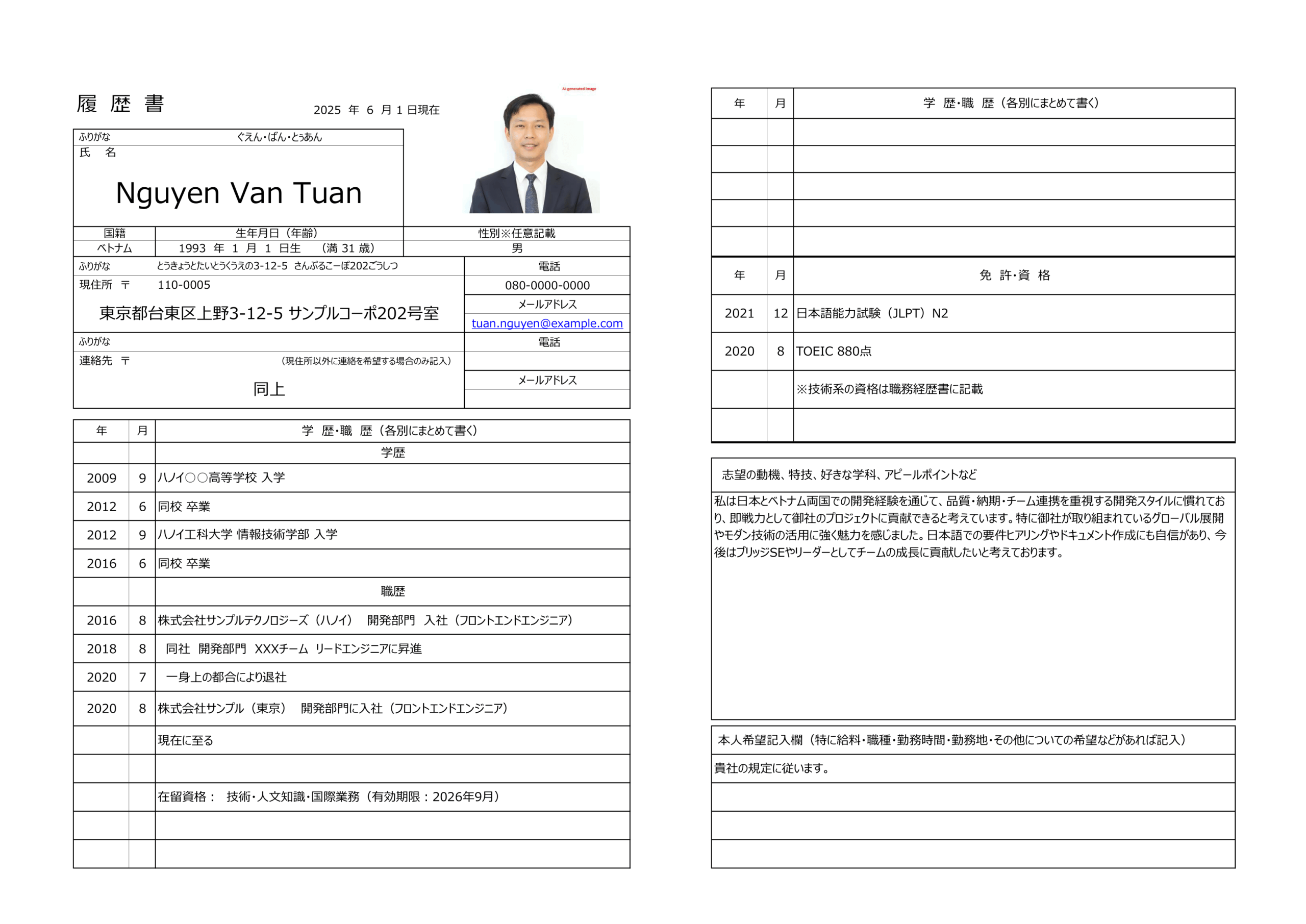
Please note that the information in this resume is for illustrative purposes only.
What Is a Shokumukeirekisho (Japanese CV)?
A shokumukeirekisho is a document used to highlight your professional experience, strengths, and achievements in detail.
It typically includes descriptions of the projects you’ve worked on, your specific responsibilities, accomplishments, and the skills you gained—often supported by concrete examples.
Recruiters use the shokumukeirekisho to assess whether your background and abilities match the needs of the position and the company.
While the rirekisho serves to communicate your basic personal and academic information, the shokumukeirekisho plays a more strategic role: it shows what kind of value you can bring to the organization.
This document is especially important for mid-career job seekers and should be carefully structured to effectively showcase your strengths and potential contributions.
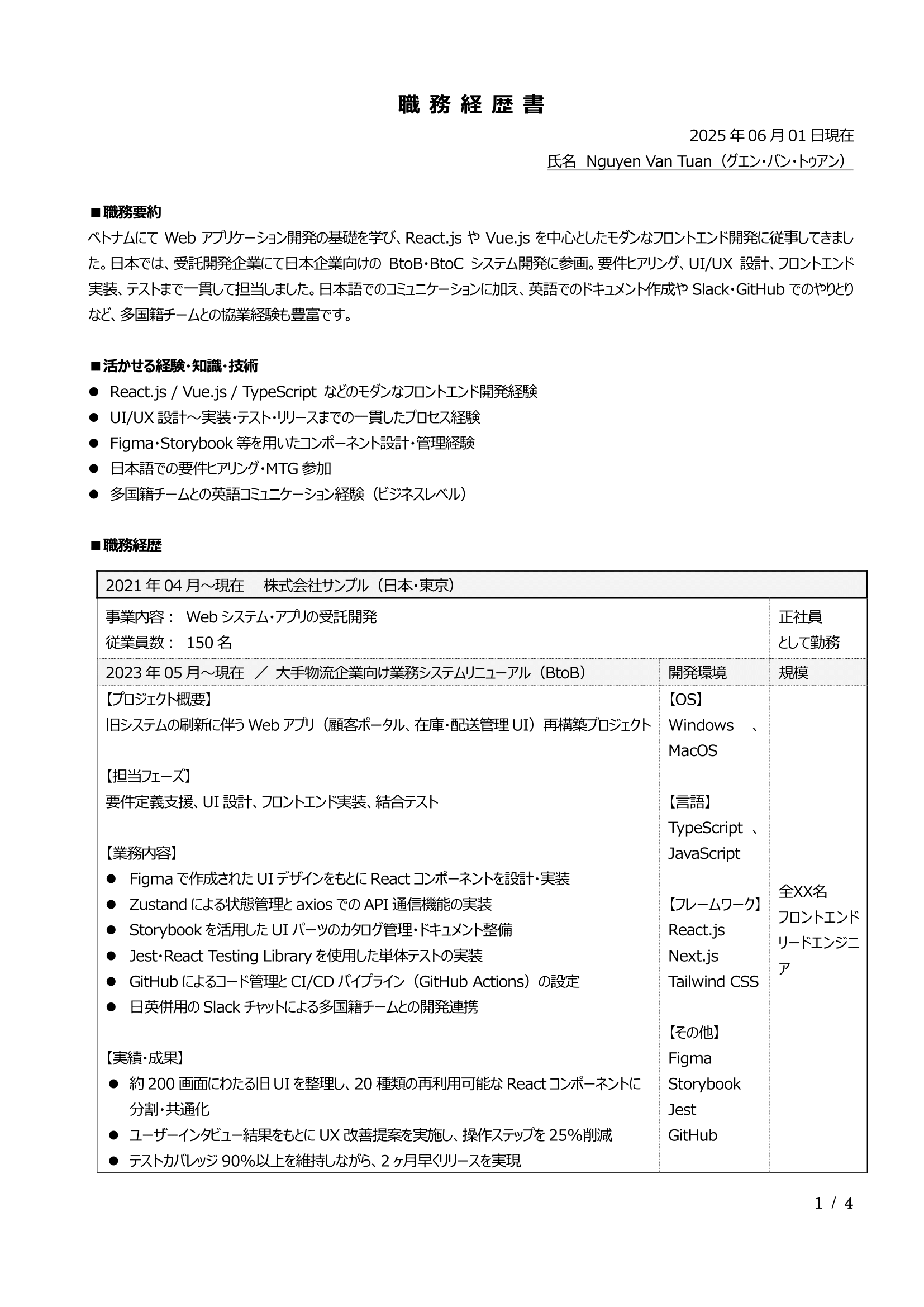
Please note that the information in this resume is for illustrative purposes only.
Do You Really Need Both?
Yes—because rirekisho and shokumukeirekisho serve different purposes, it’s standard practice in Japan to submit both when applying for a job.
The rirekisho provides your basic personal information, such as your name, contact details, education, work history, and qualifications.
On the other hand, the shokumukeirekisho goes into detail about your professional experience, skills, and achievements, allowing you to showcase your strengths in a more personalized way.
Unless a company specifically requests only one document, submitting both is considered proper etiquette in the Japanese hiring process.
Download Japanese Resume/CV Templates
If you would like to receive Japanese-style resume (rirekisho) and CV (shokumukeirekisho) templates, please fill out the registration form below.
A download link will be automatically sent to the email address you provide.
Please note: To ensure security, we do not offer open access downloads. Templates are distributed only through a registration-based system. Thank you for your understanding.
How to Write a Rirekisho (Japanese Resume) – Step by Step
A rirekisho is a standardized Japanese resume used to objectively present your personal and professional background.
It includes your name, address, education, work history, qualifications, and motivation for applying—all presented in a clear format to help employers understand who you are.
This section will walk you through how to fill out each part of the rirekisho, step by step.
Basic Personal Information(基本情報)
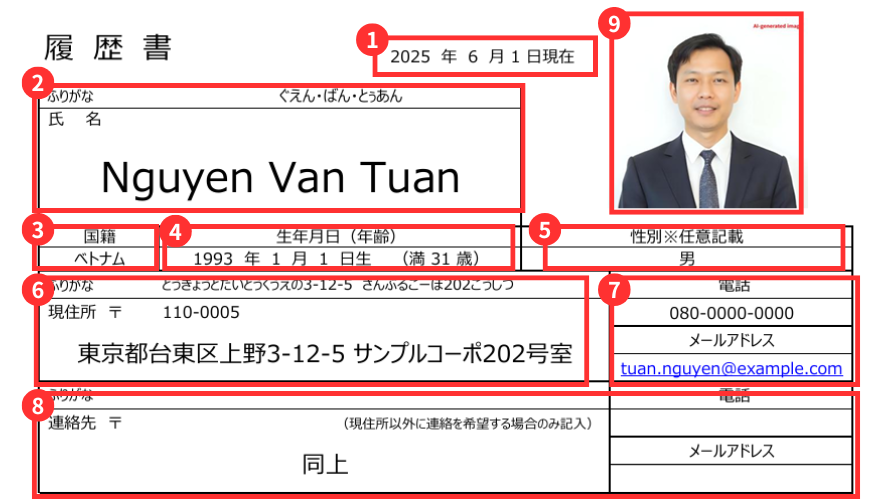
① Resume Creation Date
Write the date you are submitting the resume (Year / Month / Day).
It’s also acceptable to write the date you created the document, but if the date is more than three months old, the resume may be seen as outdated.
To avoid this, it’s best to update the date to match your application timing.
② Name
In this section, you will enter your full name.
First, in the furigana (phonetic reading) field, write how your name is pronounced.
This is usually written in hiragana, but it’s also acceptable to use Roman letters (English spelling), especially if you are a non-native speaker of Japanese.
If you come from a country that uses Chinese characters (such as China or Korea), you may also write your name using kanji, if applicable.
Below that, in the “Name” field, write your full name in English or katakana.
Make sure to follow the Japanese name order: Last Name first, followed by First Name, with a single half-width space in between.
Example: Tanaka Taro (or タナカ タロウ)
③ Nationality
Write your nationality (country of origin) in this section.
Even if you are a permanent resident or long-term resident in Japan, it is standard practice to write your country of origin here.
Details such as your visa type or residence status should be entered in a separate section or in your shokumukeirekisho (CV), not in the nationality field.
④ Date of Birth (Age)
Enter your date of birth in the following format:
[Year]年 / [Month]月 / [Day]日生
For example, if you were born on March 15, 1995:
1995年3月15日生
The final character “生” simply means “born.”
For your age, use the following format:
満〇歳 (e.g., 満30歳)
Here, “満” refers to your current full age, meaning your actual age as of the date you’re writing the resume.
If your birthday hasn’t occurred yet this year, calculate your age based on the previous year.
⑤ Gender
This field is for indicating your gender.
Typically, you can write “Male” (男) or “Female” (女). However, this item is optional, and it’s perfectly acceptable to leave it blank.
In recent years, diversity and inclusion have become more widely recognized in Japan, and not including your gender is unlikely to negatively affect your application.
If you prefer, you may write “Not specified” or simply use a dash (–).
⑥ Current Address
Write your current residential address here.
In the upper furigana field, write the pronunciation of your address in hiragana.
(Note: You do not need to add furigana for numbers.)
In the lower section, write your full address using kanji, including the prefecture, city, ward, and street address (e.g., 番地).
⑦ Telephone Number / E-mail Address
Provide a phone number and email address where you can be reliably reached.
- Phone Number
Enter a mobile number or another number where you can be contacted during the day.
If you are living in Japan, list your Japanese phone number.
Example: 090-1234-5678 or international format +81-90-1234-5678. - E-mail Address
Use an email address you check regularly.
Free services like Gmail are perfectly acceptable, but make sure your address is appropriate for business communication—ideally something that includes your name (e.g., taro.tanaka@gmail.com).
⑧ Contact Information (if different from above)
In most cases, this section can be left blank by simply writing “Same as above” (同上).
This means your contact information is the same as what you entered in sections ⑥ (Current Address) and ⑦ (Phone Number / E-mail).
Only fill out this section if your preferred contact information is different from your current address or phone/email.
For example, you should complete this section if:
- You want to be contacted at a different address, such as your family home.
- You use separate contact information for personal and professional purposes.
In such cases, provide the alternate address, phone number, or email here.
⑨ Photo
Your rirekisho should include a formal ID-style photo showing your upper body, taken from the front.
Basic Guidelines:
- Use a photo taken within the last 3 months.
(Older photos may no longer reflect your current appearance, such as hairstyle or facial features.) - Do not wear a hat or face mask—your full face should be clearly visible.
- In Japan, it is customary to wear formal attire (a suit, with a tie for men) in resume photos.
- The standard photo size is 40mm height × 30mm width.
Note: This differs from passport or driver’s license photo sizes.
How to Take the Photo:
- You can take your photo at an instant photo booth, commonly found in train stations and around town, or at a professional photo studio.
- If you’re creating a digital resume, use a photo with a 4:3 aspect ratio.
Presentation Tips:
- A background in white, blue, or light gray is recommended for a clean and professional look.
- If using a photo you took yourself, make sure you’re facing forward with a bright, clean appearance and a neutral or pleasant expression.
Academic and Work History(学歴・職歴)
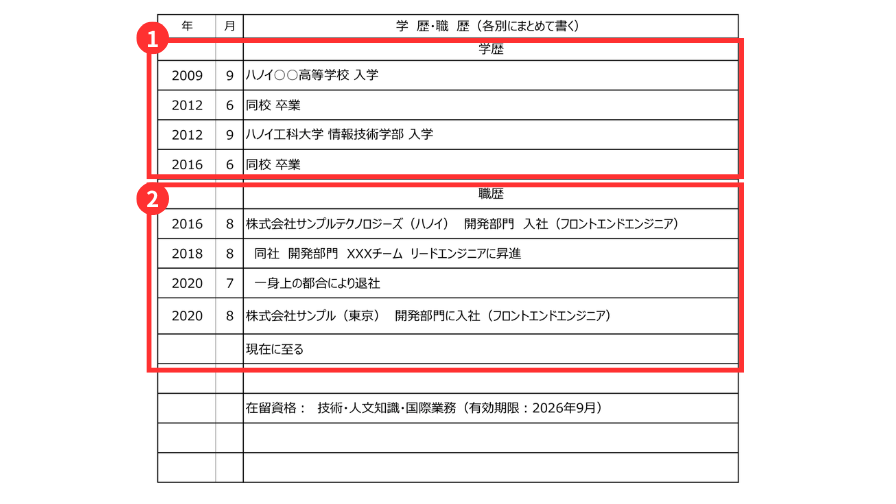
① Academic Background(学歴)
Start by writing “学歴” (Academic Background) in the center of the first line.
List your educational history from the second most recent institution onward, in chronological order (oldest to newest).
For example, if you graduated from university and later attended a Japanese language school, list your university and high school—since university is considered your highest education.
In this case, you may omit the language school (or include it below your university, if relevant).
How to Fill It Out:
- Write the official full name of each school.
e.g., 〇〇高等学校 (〇〇 High School), 〇〇大学〇〇学部 (〇〇 University, Faculty of 〇〇) - Include enrollment and graduation dates (Year/Month), written consistently in either the Japanese or Western calendar.
- Briefly mention your major or field of study for university or vocational schools.
If You Are Still in School or Did Not Graduate:
- Still enrolled:
〇〇大学〇〇学部〇〇学科 卒業見込み
→ 〇〇 University, Faculty of 〇〇 – Expected to Graduate - Withdrew:
〇〇大学〇〇学部〇〇学科 中退
→ 〇〇 University, Faculty of 〇〇 – 中退 (Withdrew) - Expelled or dismissed:
退学 → 退学 (Dismissed)
② Work History(職歴)
Leave one blank line after your academic background, then write “職歴” (Work History) in the center.
List your work history in chronological order, starting from the first company you joined. Include the following for each:
- Date of joining (e.g., 2021年4月)
- Company name (official name)
- Department and position (e.g., 営業部/営業担当 = Sales Department / Sales Representative)
- Date of resignation and reason
Standard phrases:
- For resignation:
一身上の都合により退職
→ Resigned due to personal reasons (一身上の都合により退職) - If currently employed:
現在に至る
→ Currently employed (現在に至る)
Formatting Tips:
- Use either the Western calendar (e.g., 2021) or the Japanese calendar (e.g., 令和3年), but be consistent throughout.
- If you run out of space on the left side of the resume form, continue on the right or use an extra page if necessary.
Licenses and Qualifications(免許・資格)
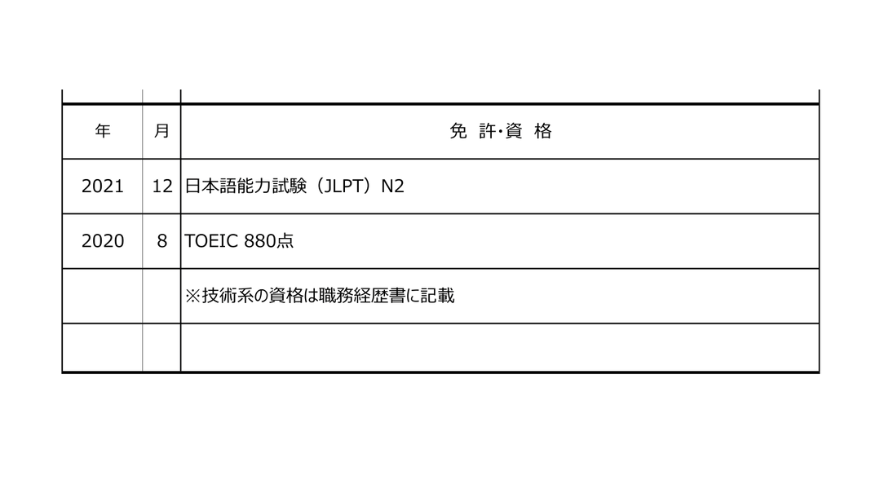
In this section, list any licenses or certifications you have obtained, using their official names.
Be sure to include the month and year of acquisition (Year / Month).
If you have qualifications that are relevant to the job you’re applying for, be sure to include them—they can strengthen your application.
Examples:
- October 2022 – Passed Fundamental Information Technology Engineer Examination (基本情報技術者試験 合格)
- March 2023 – Passed JLPT N2 (日本語能力試験 N2 合格)
- June 2024 – Obtained Class 1 Driver’s License (普通自動車第一種運転免許 取得)
If You Don’t Have Any Qualifications:
If you have no relevant licenses or certifications to list, simply write:
“None in particular(特になし)” on the first line.
If You Have Many Technical Skills:
If you have too many technical skills (e.g., programming languages, frameworks, IT tools) to fit here, write:
“For detailed technical skills, please refer to my Shokumukeirekisho (職務経歴書).”
Then list them in your separate CV or work history document.
Reasons for Applying, Skills, Academic Interests, and Strengths

This section is primarily used to write your reason for applying (志望動機).
Clearly explain why you are interested in the company or position, and why you chose to apply.
You can also include your personal strengths, special skills, or academic areas of interest to give a more well-rounded and positive impression.
Space for Personal Requests and Work Conditions
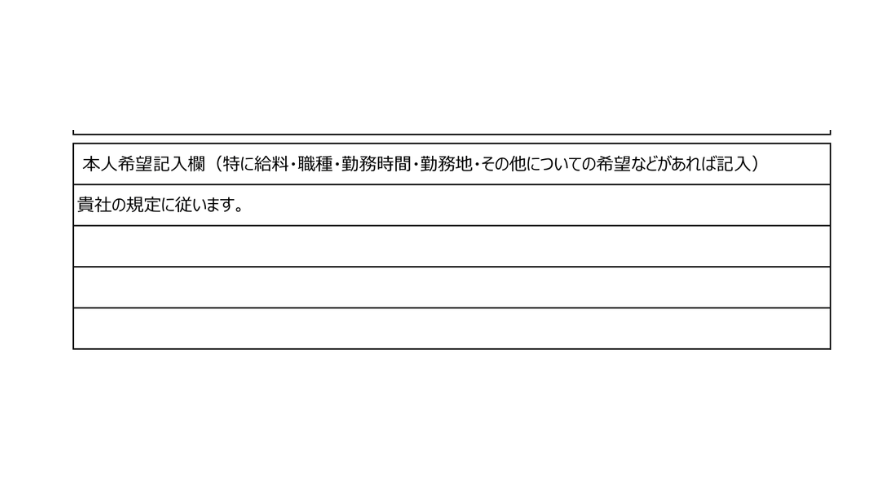
This section is for any specific requests or preferences regarding your working conditions.
You may write your preferences about job duties, work location, salary, etc., but since these are usually discussed during the interview process, it is common to leave this section simple unless you have strong preferences.
Common phrase (if you have no specific requests):
I will comply with your company’s regulations.
(貴社規定に従います)
This one sentence is perfectly acceptable in most cases.
If you do have requests, be sure to express them politely and flexibly.
Examples (if you have preferences):
I prefer to work in the Tokyo area, but I will follow your company’s decision.
(東京都内での勤務を希望いたしますが、貴社のご判断に従います)
I would prefer to focus on system development work.
(業務内容に関しては、システム開発業務を中心に希望いたします)
How to Write a Shokumukeirekisho(CV) – Step by Step
①Career Summary
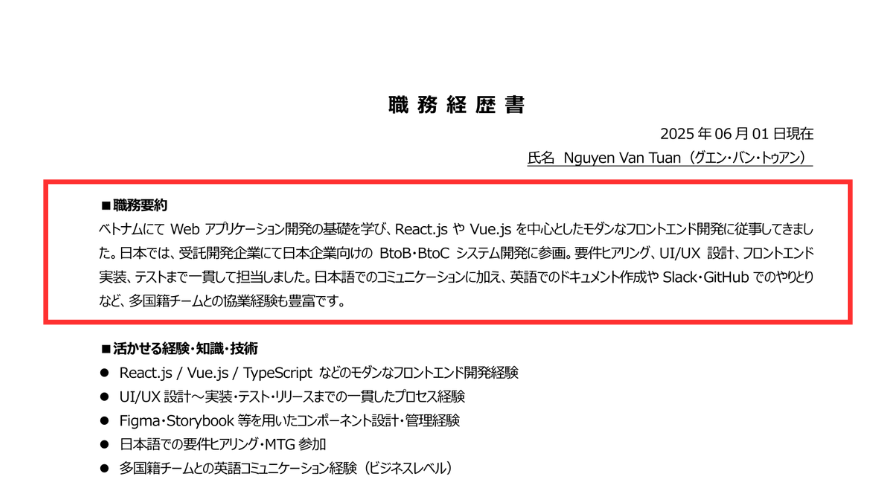
Begin your CV with a concise career summary that highlights your key experiences, technical focus areas, and soft skills. For example:
“After studying web application development in Vietnam, I specialized in modern frontend frameworks such as React.js and Vue.js. In Japan, I’ve worked on B2B and B2C system development projects, handling everything from requirement hearings and UI/UX design to implementation and testing. I’m experienced in cross-cultural collaboration, using Japanese for meetings and English for documentation and asynchronous team communication.”
②職務経歴 – Work Experience
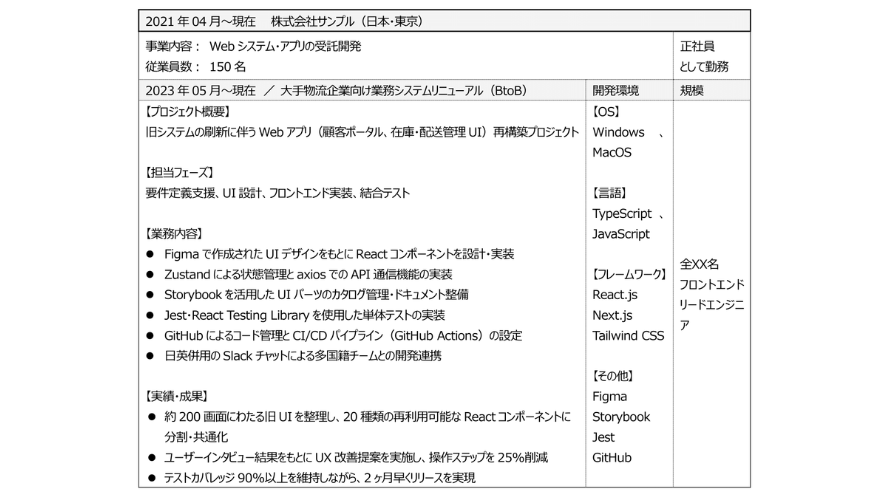
List your work experience in reverse chronological order. Include:
- Employer name, location, and employment period
- Project overview and your responsibilities
- Key technologies used
- Team structure
- Role/title
- Outcomes and achievements
Technical Skills and Tools
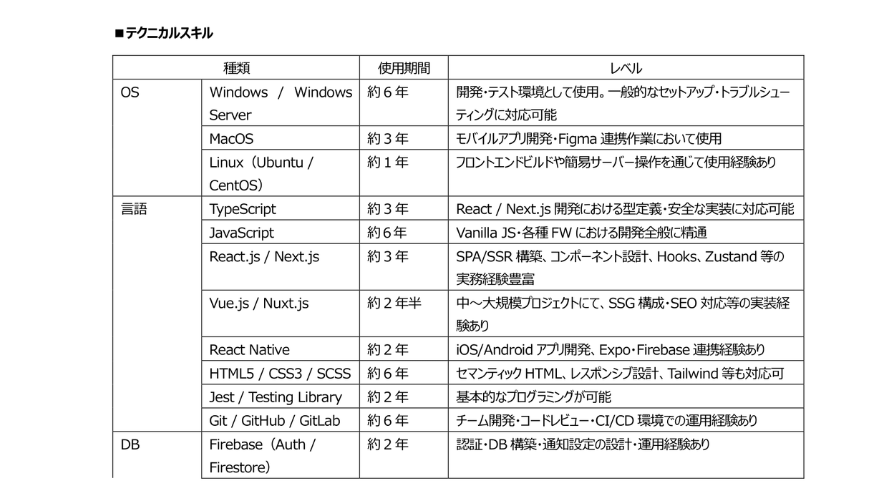
Break down your tech stack into categories such as:
- OS: Windows / Mac / Linux
- Languages & Frameworks: TypeScript, JavaScript, React.js, Vue.js, Next.js, Nuxt.js
- Tools: Figma, Storybook, Firebase, GitHub, Lighthouse, CI/CD (GitHub Actions)
- Testing: Jest, React Testing Library
Use a table or bullet list to clarify years of experience and proficiency level.
Self-PR(自己PR)
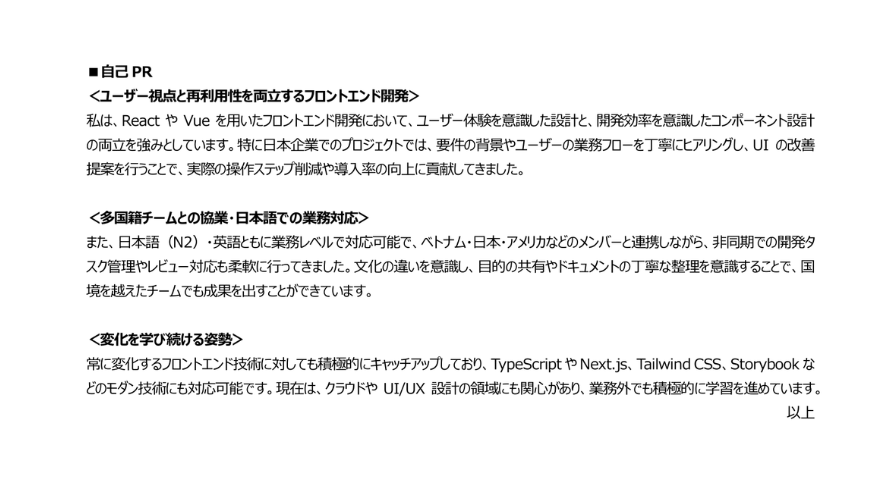
End your CV with a Self-PR (personal statement) that ties together your skills, mindset, and strengths. For example:
“I specialize in frontend development that balances user experience and code reusability. In Japan, I’ve contributed to improving UX by proposing workflow-based UI improvements. My bilingual skills (Japanese N2 / English business level) and experience across multinational teams enable me to manage cross-cultural communication effectively. I actively study modern frameworks like Next.js and TailwindCSS and am also expanding into cloud and UX design fields.”
Tips for Writing a Strong Resume and CV in Japan
Writing a resume or shokumukeirekisho for a job in Japan is different from creating a Western-style CV. Japanese employers often emphasize cultural fit, professionalism, and team contribution over self-promotion. Here are key tips to help your CV stand out:
Focus on Teamwork and Communication
In Japan, individual performance is important—but how you worked within a team is often more valued.
Instead of just writing “I developed a frontend feature,” show how you collaborated:
“Worked closely with backend engineers and UI/UX designers to develop a booking interface, ensuring smooth communication between Japanese and offshore teams.”
Mention your language abilities and communication style, especially if you’ve used Japanese in meetings, written documentation, or coordinated across time zones. For example:
“Participated in weekly Japanese-language meetings to gather requirements and summarize in English for offshore members.”
Quantify Achievements
Numbers make your resume more convincing and easier to understand—especially for HR teams unfamiliar with technical terms.
With specific outcomes:
Other examples:
- “Released product two months early while maintaining 90%+ test coverage.”
- “Achieved 30,000+ app downloads in U.S. market with 4.6-star average rating.”
Even approximate numbers help—don’t leave them out.
Keep It Professional and Formal
Japanese resumes are expected to be polite, objective, and cleanly formatted.
- Avoid casual or overly confident language (e.g., “I’m a genius at React” → ×)
- Use formal expressions like:
- “Participated in…” / “Contributed to…”
- “Responsible for…” / “Led the implementation of…”
- “Participated in…” / “Contributed to…”
Keep design simple and fonts clean. Avoid flashy layouts or icons unless you’re applying for a design-related role.
Self-PR (自己PR) should focus on your professional strengths, not personal hobbies or lifestyle preferences.
Common Mistakes Foreign Applicants Make
Even skilled engineers sometimes struggle with job applications in Japan—not because of their experience, but because of how they present it. Below are common mistakes that can reduce your chances, and how to avoid them.
Submitting Only an English Resume
Many foreign applicants submit only an English CV—but most Japanese HR teams require a Japanese resume (履歴書・職務経歴書). Even if the hiring manager can read English, the first screen is often done by non-technical staff.
Ignoring the Japanese Format
Japanese resumes follow strict formats, especially the Rirekisho (basic resume) and Shokumukeirekisho (detailed CV).
Common format mistakes:
- Writing paragraphs instead of bullet points
- Missing dates or job titles
- Not writing “以上” (The End) at the end of work history
Learn the standard structure and follow it carefully. It shows cultural awareness and attention to detail, both valued by Japanese employers.
Leaving the Motivation or PR Section Blank
In Japan, 志望動機 (reason for applying) and 自己PR (self-promotion) are mandatory—even for engineers.
Example:
“I’m interested in your company’s focus on logistics innovation. With my experience building scalable UI components in React, I hope to contribute to improving your platform’s user experience.”
These sections help employers judge your cultural fit, motivation, and attitude—important factors in Japanese hiring decisions.
FAQ – Frequently Asked Questions
Do I need to include all of my past jobs?
Yes, in most cases.
Japanese resumes are expected to show your full work history in chronological order, even short-term or unrelated roles.
However, you can:
- Keep descriptions short for irrelevant jobs
- Focus detailed explanations only on relevant positions
Leaving a gap without explanation may raise questions, so it’s better to include everything with simple context (e.g., “Part-time work during study” or “Temporary assignment”).
Do I need to include the reason for leaving each company?
Yes, for the basic resume (Rirekisho).
It is customary to write a short reason for leaving, such as:
- 一身上の都合により退職 – “Resigned for personal reasons”
- 契約期間満了のため退職 – “Left due to end of contract”
- 会社都合により退職 – “Resigned due to company circumstances (e.g., downsizing)”
For the detailed CV (Shokumukeirekisho), it’s optional—but including it shows transparency and prevents misunderstandings.
If you are still working at the company, write “現在に至る” (“Currently employed”) at the end.
Final Check Before You Submit
Before sending your Japanese resume and CV, make sure to review the following:
- Check for typos and missing characters.
Japanese resumes must be neat and formal. Small mistakes—such as a missing kanji or incorrect spacing—can give a negative impression. - Avoid abbreviations and slang.
Use full company names, job titles, and technical terms. Avoid informal language, emoji, or shorthand (e.g., “JS” → “JavaScript”). - Make sure your dates are accurate and formatted consistently.
Use the format YYYY年MM月 (e.g., 2021年04月) for all job entries.
Ask a Native Japanese Speaker for Review (if possible)
If you’re unsure about the wording or formatting, ask a Japanese friend, mentor, or recruitment agency to review your documents.
Why Foreign IT Professionals Should Consider THE和RKERS
At THE 和RKERS Agent, we specialize in supporting international IT professionals who want to build meaningful careers in Japan.
Whether you’re already working in Japan or considering your first job here, we understand the unique challenges you may face—language barriers, visa questions, cultural differences—and we’re here to help every step of the way.
\Software Engineers, IT Consultants, Data Scientists…/
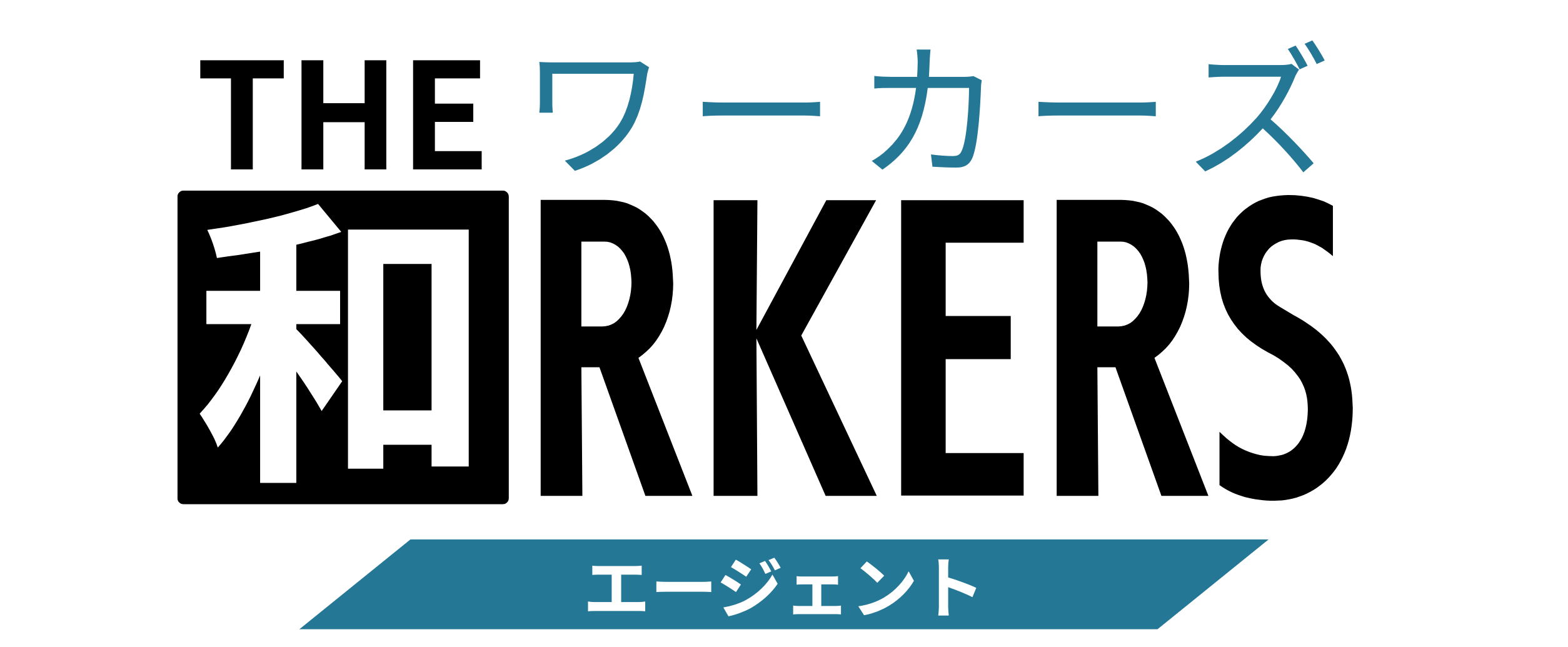
Non-Japanese and aiming for a top-tier job in Japan?
Get in touch with THE 和RKERS Agent today.



Software Engineers,
IT Consultants,
Data Scientists…

Non-Japanese and aiming for a top-tier job in Japan?
Get in touch with THE 和RKERS Agent today.
